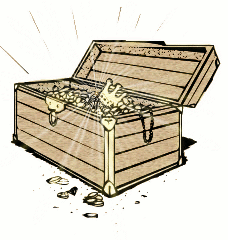Buried treasure

A buried treasure is an important part of the popular beliefs surrounding pirates and Old West outlaws. According to popular conception, criminals and others often buried their stolen fortunes in remote places, intending to return for them later, often with the use of treasure maps.
Pirate treasure

In reality, pirates burying treasure was rare: the only pirate known to have buried treasure was William Kidd,[1] who is believed to have buried at least some of his wealth on Long Island before sailing into New York City. Kidd had originally been commissioned as a privateer for England, but his behavior had strayed into outright piracy, and he hoped that his treasure could serve as a bargaining chip in negotiations to avoid punishment. His bid was unsuccessful, however, and Kidd was hanged as a pirate.
In English fiction there are three well-known stories that helped to popularize the myth of buried pirate treasure:[2] "Wolfert Webber" (1824) by Washington Irving, "The Gold-Bug" (1843) by Edgar Allan Poe and Treasure Island (1883) by Robert Louis Stevenson. They differ widely in plot and literary treatment but are blood kin from the common ancestor of the William Kidd legend.[3] David Cordingly states that "The effect of Treasure Island on our perception of pirates cannot be overestimated," and says the idea of treasure maps leading to buried treasure "is an entirely fictional device."[1] Stevenson's Treasure Island was directly influenced by Irving's "Wolfert Webber", Stevenson saying in his preface "It is my debt to Washington Irving that exercises my conscience, and justly so, for I believe plagiarism was rarely carried farther... the whole inner spirit and a good deal of the material detail of my first chapters... were the property of Washington Irving."[3]
In 1911, American author Ralph D. Paine conducted a survey of all known or purported stories of buried treasure and published them in The Book of Buried Treasure.[4][5] He found a common trait in all the stories: there was always a lone survivor of a piratical crew who somehow preserved a chart showing where the treasure was buried, but unable to return himself, he transfers the map or information to a friend or shipmate, usually on his deathbed.[5] This person would then go search in vain for the treasure, but not before transferring the legend down to another hapless seeker.[5]
Famous and notorious cases
The Roman historian Dio Cassius says that, in the early 2nd century, the Dacian king Decebalus had changed the course of river Sargetia and buried tons of gold and silver in the river bed. Later he ordered the river to be restored and the slaves involved in the works to be executed. However one of his nobles revealed its location to the Romans. The Byzantine historian Jordanes tells a similar story of the burial of the Visigoth king Alaric I and his treasure under the river Busento in 410.
There are a number of reports of supposed buried pirate treasure that surfaced much earlier than these works, which indicates that at least the idea was around for more than a century before those stories were published. For example, extensive excavation has taken place on Oak Island (in Nova Scotia) since 1795 in the belief that one or more pirate captains had stashed large amounts of loot there. These excavations were said to have been prompted by still older legends of buried pirate treasure in the area. No treasure has ever been reported to be found.
The Treasure of Lima is a supposed buried treasure on Cocos Island in the Pacific left there by pirates.[6] The treasure, estimated to be worth £160 million, was stolen by British Captain William Thompson in 1820 after he was entrusted to transport it from Peru to Mexico.[6]
The only authenticated treasure chest in the United States, once owned by Thomas Tew, is kept at the Pirate Soul Museum in St Augustine, Florida.[7]
Closer to modern times, the notorious drug lord, Pablo Escobar buried large sums of money in the form of US currency across Colombia. While a lot of it has been retrieved, large portions still remain buried.[8][9]
Former corsair turned pirate, Olivier Levasseur known as "The Buzzard", is known to have hidden one of the biggest treasures in pirate history, estimated at over 4,5 billion euros, and leaving a cryptogram (with templar alphabet) behind with its whereabouts.[10] In 1994, Bibique, whose real name was Joseph Guy Germain Tipveau, discovered a hint between the manuscript & a rock (discovered at the Ravine of despair) exposed at the City Hall of La Possession, in the isle of La Réunion. In 1949, Reginald Cruise-Wilkins while being sick with malaria, meets Captain Goldvorg, who introduces him to Madam Rose Savy. At her house, he found out that she discovered engraved marks & demarcation lines on rocks during the 1920s, letting her to the conclusion that those were pirate symbols. She visited the French National Library (Bibliothèque Nationale de France) and received confirmation that the documents she possessed originated from La Buse. Cruise-Wilkins bought those documents for $29, after that, he started great searches for the treasure (he found only a flintlock rifle, sword blade, figurines and a few coins; pale reward for a 30.000 sterling pounds investment). After his death, in 1977, John Cruise-Wilkins took on his father's search (siding with an American investor) using dynamite on the coastal rocks. Jacques et Edward, two other treasure-hunters, searched deep in the jungle, where they discovered ruins, an old coffer, a bell, lanterns, and bones (they were at odds with Wilkins, after a quarrel, where they supposedly fabricated markings on the rocks). A popular story tells that in the same island many other pirates buried their own treasures; like Hodoul, Boudin, Avery, Kid, Halsay ou Taylor... Nowadays, John Cruise-Wilkins still searches for the treasure of La Buse, in the Seychelles, at the site of Bel-Ombre, north of Mahé. There he found a cavern with a network of tunnels. He indicated that all modern technology are useless because of the omnipresence of minerals & Iron Pyrite ("Fool's Gold") inside the rocks.
Buried treasure is not the same as a hoard, of which there have been thousands of examples found by archaeologists and metal detectors. Buried treasure is as much a cultural concept as an objective thing. It is related to pirates and other criminals who leave stolen artifacts behind for later retrieval, typically in remote places like islands, sometimes with maps leading back to the treasure.
See also
References
- 1 2 Cordingly, David (1995). Under the Black Flag: The Romance and Reality of Life Among the Pirates. ISBN 0-679-42560-8.
- ↑ Paine, pp. 27–28
- 1 2 Paine, pg. 28
- ↑ The Book of Buried Treasure at Internet Archive (scanned books original editions)
- 1 2 3 Simon Garfield. On the Map: Why the World Looks the Way It Does (2012). Pgs. 176-180
- 1 2 Jasper Copping (5 August 2012). "British expedition to Pacific 'treasure island' where pirates buried their plunder". The Telegraph. Archived from the original on 12 August 2012. Retrieved August 12, 2012.
- ↑ Abravanel, Lesley; Miller, Laura Lea; Miller, Laura (2010-07-30). Frommer's Florida 2011. p. 302. ISBN 9780470890219.
- ↑ Parker, Mike (2009-05-03). "Hunt for drug lord's millions". Express.co.uk. Retrieved 2017-03-20.
- ↑ Rawle, Tom (2016-09-02). "Where are Pablo Escobar's secret millions? Narcos drug lord hid fortune to never be found". Dailystar.co.uk. Retrieved 2017-03-20.
- ↑ DECAYEUX, Alain. "Biographie du pirate Olivier Levasseur dit La Buse - Pirates & Corsaires célèbres". www.pirates-corsaires.com. Archived from the original on 5 February 2018. Retrieved 30 April 2018.

